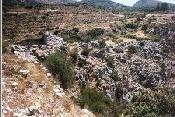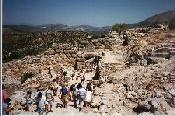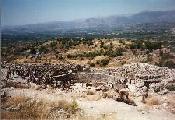Mycenae was once a great city. They were one of the power houses in the days where city states such as Athens,Corinth, and Sparta controlled the region. The wealth that they obtained was enormous. The riches of kings were uncovered in the various burial sites. Many of those riches are on display in the Athens' Archaeological Museum. At one point the Mycenaens had control of the island of Crete which most likely aided in their control of the region.
However, Mycenae is best
known from Mythology. Here is the readers digest version of events
surrounding the city:
Agamemnon, king of Mycenae, had a brother named Menelaus, who
was the king of Sparta. These two brothers married two sisters, Clytemnestra
and Helen. Clytemnestra was Agamemnon's bride and Helen was Menelaus. Helen
was of renowned beauty and was offered to a Trojan prince, Paris, by Aphrodite
(Goddess of Beauty and Love) by judging her the most beautiful Goddess.
So Helen went, some what willingly, with Paris to Troy. This enraged the
brothers and Agamemnon arranged an expedition to go to Troy and bring back
Helen. However, Artemis (Goddess of the hunt, and of the moon) stopped
the winds from blowing because Agamemnon had shot one of her prized deer,
and made him sacrifice his daughter, to make amends and to bring the wind
back. After this, the party of Greeks was able to set sail for Troy.
This resulted in the Trojan war, a war that lasted ten years. (The Iliad,
Homer)
During this ten years, Clytemnestra finds a lover, Aigisthos and the two rule Mycenae together after they drive Agamemnon's son Orestes and his remaining daughter, Electra, into Exile. Upon Agamemnon's return, this pair slaughter Agamemnon in his bath with an ax. Ten more years pass and Orestes finds him self at the Temple of Apollo (God of light and the sun) at Delphi. Apollo tells Orestes that to avenge his fathers death, he must slay his mother and her lover. So he returns to Mycenae and kills Clytemnestra and Aigisthos. Because he killed his mother The Furies rise up from the Earth and try to take vengeance for the death of Clytemnestra(Killing ones mother was a serious crime) The Furies chase Orestes to Delphi where Apollo tells Orestes to go to Athens and ask for Athena's forgiveness. So he then goes to Athens where he seeks shelter in the temple of Athena (Goddess of wisdom, patron of Athens) and begs for forgiveness. He is put on trial by the Athenians in front of the Aropagus. The jury reports a six six tie and Athena casts the final vote finding him not guilty. This was the first instance of a jury trial. Athena then had to ask the Furies to spare the city from their wrath and the furies agreed and became the Eumnides, the benevolent ones, blessing the earth with fertility and fruitfulness. (The Libation Barriers, Eumnides)
This is just the readers digest version of myths involving Mycenae. It is believed that these events may have happened then were embellished by poets. The city does indeed exist and it attracts a large amount of people, mainly because of the "royal tombs" that were uncovered there. The site has been in ruins since at least the second century A.D. These pictures are to give you a feel for what the site is like. .

Mycenae, the Site |

The Valley Below |
| As I said above Mycenae is on a hill, with taller hills on all sides. You can see ruins of city walls, and the Acropolis above that. Not much is left now, but in its heyday the city was highly defensible. | This is looking right down into the valley on the southern face of Mycenae. Quite hard to climb up. It also gives you an idea of what it looks like around the site. |

The Lions Gate |

Second Circle of Royal tombs. |
| The Lions Gate is the main entrance into the city. The lions, with their fore paws on an alter of some sort was suppose to represent the mycenaean's power. Anyone coming to the Acropolis would have to enter through these gates. Also notice the walls on the right hand side had the people walking by them. I'm amazed at how these things could have been moved. | This is the "second" circle of royal tombs, located outside of the Acropolis. These tombs are thought to be older than the first circle of royal tombs (below). They were mostly shaft graves and provided Archaeologists with a lot of information about the city. What I find interesting is that I saw a buried structure (right center) like this in a set of Greek ruins in Italy. I wonder if this was just a style of houses or or the structure in Italy was a grave of some sort? |

Back of Lions Gate |

First Circle of Royal Tombs |
| This is looking back towards the Lions gate. There is a granary on the left hand side of the gate and I am not sure what is on the right. you can see the people marching in the city. There is a constant stream of people through these gates. | This is the first circle of royal tombs. Which was discovered before any of the other tombs in the site. Eight men, nine Women and two children were found in these grave shafts (six in all) as well as thirty pounds of gold. All this gold led the early Archaeologists to think this was Agamemnon's grave, but later they found it dated much latter than when he was thought to have lived. I have a second picture on the next page to let you see into the graves. |
Options
| View | Part: II | Part: III |
|---|---|---|
| Return to my Home Page | Greece FAQ | Return to my Photo Gallery |
| Sign Guestbook | Guide Books | Photos for Sale |
All photos by John L. Polos
Copyright August 28, 1997
I hope you enjoy them. Any comments, please E-mail me,